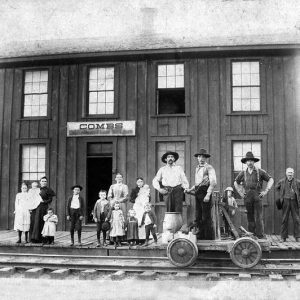calsfoundation@cals.org
Combs, Cass and Eastern Railroad
The Combs, Cass and Eastern Railroad Company (CC&E) has several distinctions. It was the last railroad built in northwestern Arkansas. It reached the highest elevation of the railroads operating in northwest Arkansas and was the sole standard gauge logging railroad there. Prominent Arkansan J. William Fulbright became president at the age of eighteen, thus becoming the youngest railroad president in the United States.
Construction of the then-unnamed railroad began in 1913 at Combs (Madison County) on the St. Paul (Madison County) branch of the St. Louis–San Francisco Railway (Frisco). The line headed south along Mill Creek for nearly nine miles. Upon entering Franklin County, the railroad encountered difficult rock conditions as it climbed to Summit (Franklin County) at about 1,900 feet above sea level, the highest elevation of any railroad in northwestern Arkansas.
Four long wooden trestles were required to cross canyons. One trestle was on land in the Ozark National Forest, which required that the railroad be incorporated as a condition of leasing the right-of-way. The name selected in January 1915 was the Black Mountain & Eastern Railroad Company. The largest trestle, located 12.8 miles south of Combs, was 385 feet long and 77 feet high. The Arkansas Railroad Commission, formed in 1899 to regulate railroad construction, learned of the existence of the railroad in October 1915. By then, the Black Mountain & Eastern had been in operation nearly three years and had thirteen miles of track in operation. The railroad received authorization to continue construction.
The railroad owned five cars; all lettered “Black Mountain & Eastern,” these included two boxcars, one ex-Frisco caboose, and two gasoline-powered maintenance vehicles. The railroad likely relied on the Frisco for flat cars to carry semi-finished timber to the large J. H. Phipps mill in Fayetteville (Washington County) and a smaller Phipps mill at Combs. The Frisco had also provided bridge-building equipment to construct the four large trestles.
The railroad changed its name to Combs, Cass and Eastern Railroad Company in August 1916. Contemporary railroad financial reference works stated that the railroad intended to build an additional twelve miles of track from the town of Cass (Franklin County) eastward to reach new timber resources near Yale (Franklin County). The slow construction process finally ended when High Cass (Franklin County), about 540 vertical feet above the community of Cass, was reached in late 1916. The completed line was sixteen miles long. The railroad built a wye (a set of three switches and three tracks) so that the line’s single ex-Frisco steam engine, No. 347, a 2-6-0 Baldwin built in 1892, could reverse direction when heading back to Combs. The engine normally left Combs at 6:30 a.m. and returned in the evening after a day spent assembling timber trains.
In 1917, the railroad first reported that it owned a “passenger train car.” It was powered by two gasoline engines and was used to carry passengers between Combs and Cass. The car had begun as a Fort Smith Light and Traction Co. horse-pulled car that became obsolete in about 1910.
When the railroad reached High Cass in late 1916, the only way to move freight to and from Cass was by a winding wagon trail. In 1922, the railroad constructed a standard gauge two-mile switchback that enabled rail equipment to enter Cass. The grades on the switchback were steep, and the steam engine generally did not operate to Cass. Instead, the railroad relied on two motor trucks with flanged wheels to move cars to and from Cass via the switchback.
The railroad never covered its operating expenses throughout its existence. It relied on loans from its parent J. H. Phipps Lumber Company to fund the continuing deficits. In 1918, Jay Fulbright of Fayetteville acquired a controlling interest in the railroad. When he died in 1923, his son J. William Fulbright succeeded him as president. The last year of significant freight business was 1923, with revenues of $9,326. Passenger revenues had peaked at $1,094 in 1920.
The Combs, Cass and Eastern traversed difficult terrain, and maintenance costs were likely high for a railroad with declining revenue. In 1925, Fulbright sought to abandon 9.08 miles of line between High Cass and Frazier (Franklin County). After a long struggle with Interstate Commerce Commission bureaucrats, the railroad obtained approval to abandon the track any time after December 24, 1925. The railroad applied to abandon the remaining 6.94 miles of track in 1929, but the application was rejected because it did not comply with Interstate Commerce Commission procedures. As a practical matter, the railroad ceased to exist sometime in 1928 when it returned the track it rented to the Frisco.
Much of the railroad still exists in the form of massive rights-of-way blasted through rock near Frazier and the huge earthen abutments for the four trestles. Large bolts and nuts from the trestles abound. The switchback to Cass is easily visible as is the wye a mile from the line end at High Cass. Most amazingly, “passenger train car” No. 10 survived and, after years of service at nearby Turner’s Bend, went to the Fort Smith Trolley Museum in the early 1990s. The car awaits restoration as Fort Smith Trolley Museum resources permit.
For additional information:
“Abandonment of Part of the Combs, Cass and Eastern R.R. Co.” Interstate Commerce Commission Reports. Vol. 105, Finance Docket 4979. Washington DC: Interstate Commerce Commission, 1925.
Henry, George M. “History of Franklin County.” Master’s thesis, University of Wyoming, 1940, 26–27.
Interstate Commerce Commission Reports. Vol. 141, Valuation Docket 452. Washington DC: Interstate Commerce Commission, 1926.
Tom Duggan
Lowell, Arkansas
 Combs Train Depot
Combs Train Depot 




Part of this line has become incorporated in the Ozark Highlands Trail. I hiked that section recently and was astounded to see how much earth was moved to create the rights of way and just to cut a flat track surface into the hillsides even. That was a lot of hard work with the sorts of equipment and tools they had at the time!